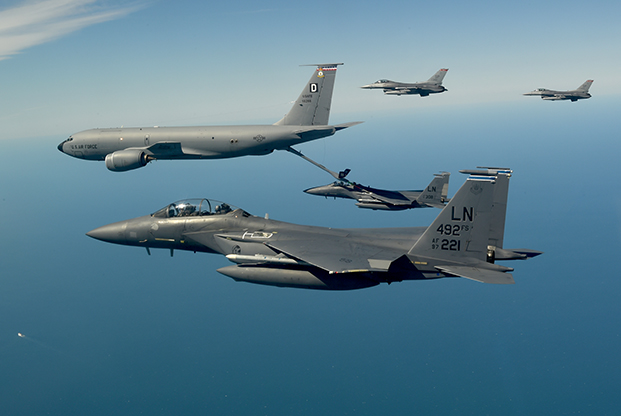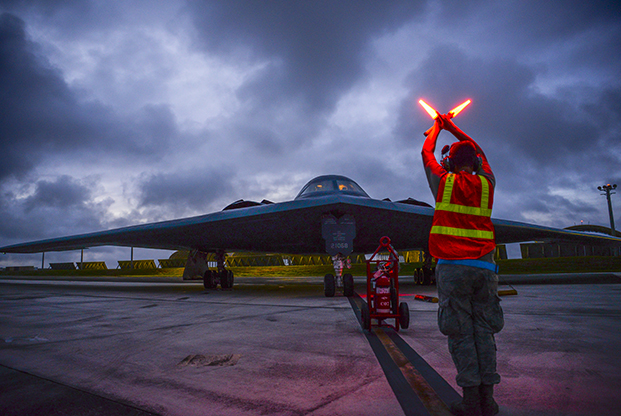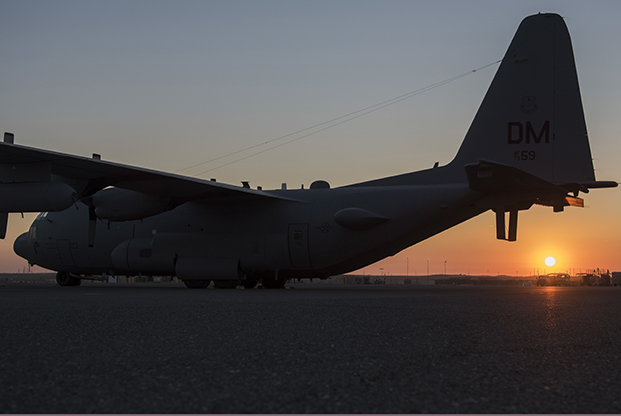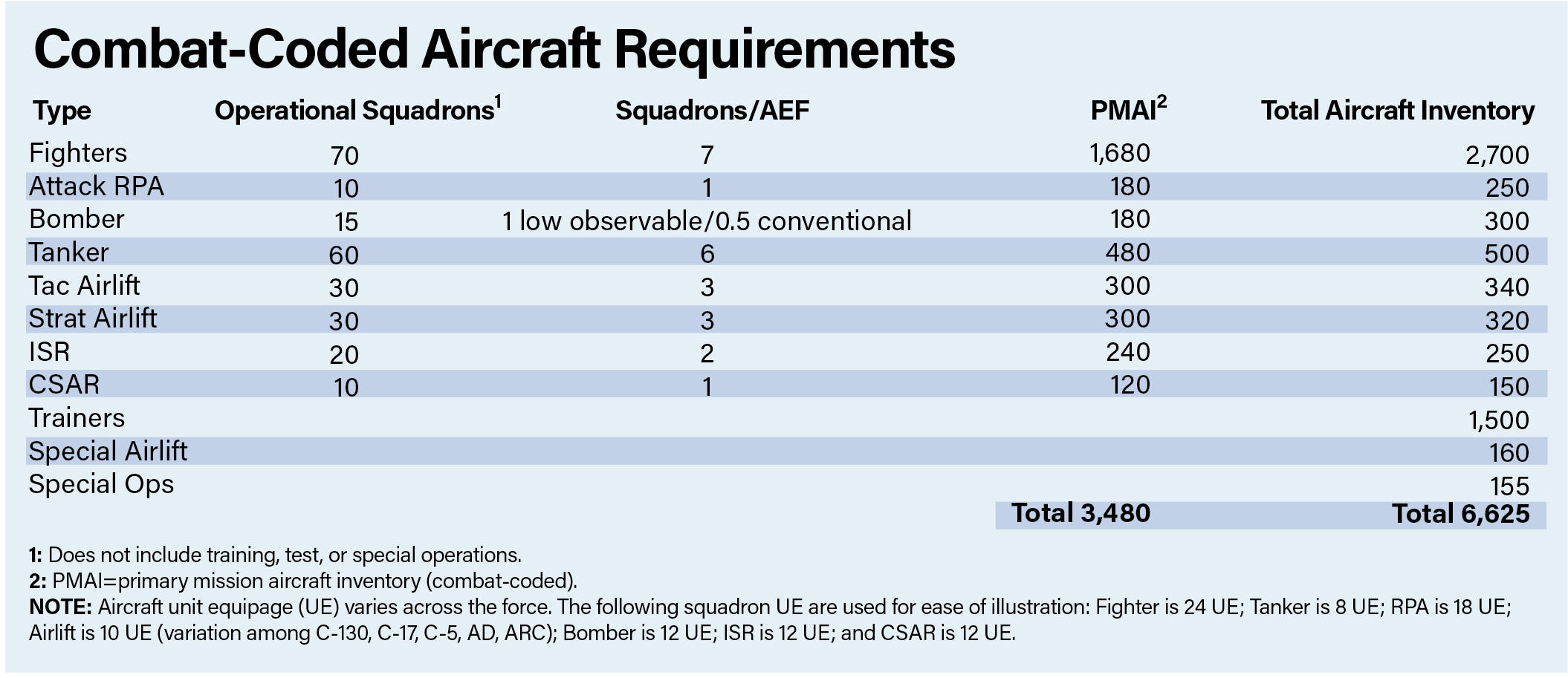
A KC-135 refuels fighters during a training mission over the Baltic Sea. Air-refueling orbits are an essential component of the American way of war. Photo: TSgt. Roidan Carlson
Secretary of the Air Force Heather Wilson issued a warning at AFA’s Air, Space & Cyber Conference last September: “We must see the world as it is. That is why the National Defense Strategy explicitly recognizes that we have returned to an era of great power competition. We must prepare.”
World events back up this assertion in no uncertain terms. With China aggressively expanding its territorial zone of control in the Pacific Ocean in excess of international norms, and Russia pursuing overt acts of hostility in places like Ukraine and Syria, the global threat environment is growing to levels unseen since the Cold War. North Korea’s possession of nuclear weapons and Iran’s continued assertiveness in the Middle East are also generating strategic-level threats from regional actors. Finally, persistent instability in places like the Middle East, Africa, and beyond continues to demand military attention. Said another way, “The security and well-being of the United States are at greater risk than at any time in decades.” This grim assessment is the opening line of the recent report by the bipartisan Commission on the National Defense Strategy for the United States. Cutting to the essence of the specific challenge facing the Air Force, Secretary Wilson stated the issue succinctly: “The Air Force is too small for what the nation expects of us.”
An undersized US Air Force means fewer national security options and the assumption of increased risk at the strategic, operational, and tactical levels of conflict. The basic reality is that Air Force airpower provides a unique asymmetric advantage for the United States through its ability to strike targets anywhere on the globe, anytime; secure and maintain theater-wide air superiority; gather vital intelligence, surveillance, and reconnaissance (ISR) on a global scale; facilitate command and control of forces; and execute global mobility in a matter of hours. These attributes are vital to empowering successful, decisive strategies against highly capable adversaries.
While the US possesses other military air assets in the Army, Navy, and Marine Corps, these aviation arms are designed to support the core functions of their respective military services. Individually, they lack the scale, scope, and capabilities necessary to facilitate independent, theater-wide, full-spectrum operations. For example, naval carrier air wings are first and foremost focused on defending surface battle groups. Their small size also limits their ability to project large-scale, sustained airpower. Marine Corps aircraft are tied to Marine Air-Ground Task Forces (MAGTFs) and are generally not available for theater taskings. The same holds true for organic Army aviation assets with their function directly assigned to their Army organizational units.
The Air Force is uniquely organized to project range, mass, lethality, and survivable power in a theater-wide fashion, free from organic surface mission obligations. Combatant commands (COCOMs) understand this value, and it is a key reason why they place a high priority on Air Force aircraft and personnel. As one Air Force leader recently detailed: “In the last five years, [Air Force Global Strike Command] has gone from supporting one enduring COCOM requirement to an average of 12 annually, a 1,100 percent increase.” Given the Air Force’s small bomber fleet of 157 aircraft, a record low number by historic standards, meeting this demand presents challenges. This is not a one-off situation—nearly every Air Force mission set is in high operational demand with fewer aircraft available than ever before in Air Force history to meet the spectrum of the nation’s national security requirements.

SrA. Cody Mehren signals a B-2 during a refueling stop at Andersen AFB, Guam. A robust Guam presence is vital to American strategy in the Pacific Ocean in the face of a rising China threat. Photo: TSgt. Jake Barreiro
FORCE-SIZING THE AIR FORCE
Recognizing the need to align available resources with demand, the Air Force leadership articulated the requirement to grow operational Air Force squadrons from 312 to 386 by the 2025 to 2030 time frame. However, 386 operational squadrons outline an organizational construct—not a force-structure plan. The missing pieces needed to make sense of the 386 figure include what actual platforms, quantity, and capabilities make up those squadrons. This detail is necessary to make the 386 squadron mark connect, hold credibility, and endure rigorous resource discussions.
Fortunately, a model already exists that can explain the demand-driven expansion required of the Air Force in terms of specific force-structure elements. In the late 1990s, the Air Force was challenged to set up a rotation of its aircraft to support the continuous demands of the no-fly zones over post-Gulf War Iraq—Operations Northern and Southern Watch—while at the same time maintaining other global commitments and carrying out combat actions.
The initial ad hoc approach stretched available aircraft and associated personnel to the breaking point at first. A rotational model known as the “Expeditionary Aerospace Force” (EAF) was created to meet the demand signal from combatant commanders, while also providing a viable rotation base to avoid burning-out personnel and equipment. The Air Force first announced the planned evolution to the EAF concept in August 1998.
The reason for the change to the EAF structure was the emerging global security environment. The end of the Cold War precipitated the shift from the previous national security strategy of Soviet containment to one of engagement. This shift resulted in major force reductions, especially in overseas locations. As a result, airmen were experiencing significantly higher deployments and operations tempo. In 1999, the Air Force conducted nearly 900 deployments, while executing over 160 operations and exercises around the world. This expeditionary approach, while renewed and refocused, is strongly rooted in the history and traditions of airpower. It was further embodied in the core competencies of the Air Force and its central missions of providing timely and responsive land- and space-based aerospace power. In turn, it facilitated the key concepts of military joint doctrine.
The biggest visible structural change was the introduction of the Air Expeditionary Force (AEF) as a means to manage Air Force aircraft and assets. Prior to this change, only 40 percent of the Air Force deployed, with 60 percent staying in garrison all the time. The AEF spread the expeditionary experience to a much greater portion of the total Air Force. Operationally it moved beyond thinking in terms of sorties generated, to focus instead on desired effects. It was an innovative operational concept designed to achieve a lighter, leaner, and more lethal force. This approach addressed the high demands the global engagement strategy placed on the Air Force. These demands included maintaining high deployment tempos and multiple, sustained forward-operating locations, while retaining rapid crisis-response capability to assure readiness for the possibility of two major theater wars breaking out simultaneously.
Each AEF is a “mini Air Force” and has sufficient numbers and types of aircraft and personnel to conduct core missions when called upon by combatant commanders. Ten were necessary to meet the needs of the national defense strategy at the time. An AEF is a group of associated units that provides a cross section of aerospace capabilities. The AEF does not deploy en masse; rather it is a resource pool from which to draw the right mix of forces to accomplish a combatant-command requirement. These task-organized forces were presented to theater commanders in the form of Aerospace Expeditionary Wings (AEWs), and their subsidiary groups, and squadrons. Elements from two AEFs were either deployed on a rotational basis or on call, with the remaining eight in sequence recovering from deployment, conducting proficiency training, or preparing to deploy. The AEF represented a well-defined package of Air Force aerospace power.
While the AEF concept remains sound, budget pressures and corresponding force-structure divestitures over the past decade strained the model, particularly when Air Force leadership tried to accommodate Army rotation policies in the midst of both Operation Enduring Freedom and Operation Iraqi Freedom as they dragged on into the late 2000s. The Air Force became so small that balanced force rotations were no longer possible, and the AEF concept was shifted to meet ground-force demands. This shift would become one of the principal drivers behind the current pilot crisis and result in reduced readiness to respond to major regional conflicts. People and equipment burned out at a rapid rate—the exact circumstances a sustainable rotation-based model was designed to prevent.
The EAF/AEF construct was built and applied as a force-management tool. It never broke, it was simply under-resourced. It is important not to conflate the cause and the effect. With proper inventories of people and equipment, the Air Force could and should reconstitute a viable AEF construct. A balanced force-rotation model will prove vital in ensuring mission demand can be met over the long haul in a viable, credible, and sustainable fashion. This construct can be adapted as a force-structure-sizing tool for the Air Force as it connects the objectives of the US national security and defense strategies directly to the force structure necessary to reach those objectives. In fact, this tool aligns well with the numbers Wilson articulated during her September 2018 pronouncement on the size of the Air Force necessary to implement current national security strategy.
Furthermore—and most important—using the AEF as a force-sizing methodology provides the Air Force a logical, relevant, and easily understandable means for the American people and Congress to comprehend the tie between the demands of the national security and defense strategy and the quantity and types of aircraft needed to execute them. Specifically, there are two tenets of American national security strategy over the last quarter century that have endured through presidential administrations of both political parties. First, the US will maintain sufficient forces and capabilities to engage around the world to encourage, shape, and maintain regional peace and stability; and second, in the event the US does need to fight, it will do so in an expeditionary fashion away from American territory in a manner that puts our adversary’s value structures at risk, while maintaining the ability to win more than one major regional conflict at a time.
In order to be able to fulfill both of these tenets, the Air Force needs enough robust, capable, and ready forces to establish a rotational base sufficient to sustain peacetime engagement operations. To do that, the Air Force can use its AEF structure to maintain sufficient numbers of rotational forces. With respect to the second major requirement of both national security and defense strategies—the ability to win more than one major regional conflict at a time—historically, this has required five AEFs worth of capability per major regional conflict (or 10 AEFs). This requirement was articulated explicitly in the early 1990s during DODs “Bottom-Up Review” (BUR) and remains today, although language in subsequent defense reviews cleverly reformulated the construct to match the reality of periodic defense budget cuts. Arbitrary budget constraints—not threats or strategy—have driven the most significant changes to the Pentagon’s force-planning policies since the 1993 BUR. The return to great power competition and growth of major regional threats, such as Iran and North Korea, have revitalized this important force-sizing concept.
As an illustrative example of how the AEF can work as a force-sizing mechanism, consider the bomber force through the lens of the AEF. With respect to the current US defense strategy, there is a baseline, long-term requirement for one squadron of 12 combat-coded B-21s per AEF. This results in a requirement for 120 combat-coded B-21s—or 10 operational squadrons at 12 B-21s per squadron—for forward engagement and power projection. As a rule of thumb, approximately 25 percent of a total force of combat aircraft is also needed to support training and operations, and another 20 percent is nominally planned for an attrition reserve and backup aircraft inventory (BAI). These numbers result in a total requirement for 180 long-range, penetrating B-21s (120 combat-coded; 30 for training; 30 for attrition reserve and BAI).
At the same time, because of the enormous cost-effectiveness of legacy bombers for a range of missions and their highly relevant capabilities, the US also needs a minimum of six nonpenetrating long-range strike aircraft per AEF for operations in a standoff role, or for when permissive airspace is created. This reflects mission demand seen in regions such as Iraq, Syria, and Afghanistan over the past 17 years. It is also important to highlight that, despite the age of these aircraft, their attributes would also see them engaging in a “nonpenetrating” fashion against more advanced adversaries. Including training, attrition reserve, and backup aircraft inventory, that requirement equates to a total legacy bomber force of 90 (60 combat-coded; 15 for training; 15 for attrition reserve and BAI). This would allow for five operational bomber squadrons. When viewed together, the Air Force needs a total bomber force of 270 bombers of all types, or 15 total operational bomber squadrons. Today, the Air Force possesses eight-and-a-half bomber squadrons. The situation is similiar for fighter aircraft. The AEF construct was actually used in one instance as a rationale for a particular aircraft—the F-22 Raptor. This construct established a revised requirement of 381 F-22s during the 2001 Quadrennial Defense Review (QDR), based on a nominal squadron size of 24 combat-coded aircraft per squadron.
Using the AEF model as described above, the Mitchell Institute calculates that the objective force structure that the Air Force needs to meet the force capacity required by the US National Defense Strategy is illustrated in the table (above).
The bottom line is that we have a choice: We can either fund our military to meet the demands of the National Defense Strategy, or we can lower the expectations of the defense strategy to some arbitrary budget amount.
Congress cannot go on living the fallacy that the defense budget is sufficient to execute the demands of our defense strategy.

The sun rises on an EC-130 Compass Call aircraft at an undisclosed location in Southwest Asia. Photo: SSgt. Jeremy Mosier
ADAPTING THE AMERICAN WAY OF WAR
Potential adversaries have studied the traditional American way of war—concepts of power projection that have generally remained static since the end of the Cold War. These include rapid deployment and sustainment of large air, ground, and naval forces to forward bases and littoral seas; staging, maneuver, and support of large numbers of ground forces; efficient generation of combat-aircraft sorties 24/7 from land and sea bases; secure ISR and air-refueling tanker orbits; and US possession of strategic initiative.
The US way of war is dependent on highly efficient supply chains and force-generation processes. Can US forces generate combat effects if these processes are heavily attacked? Adversaries will be capable of denying these elements in the future. They have worked to both emulate US strengths and probe US weaknesses.
Russia and China are developing fifth generation stealth fighters for their air forces today to disrupt these US warfighting elements. Chinese military leaders speak openly about using advanced anti-ship missiles to sink American aircraft carriers.
There will be no extended “spin up cycle” for future wars. Modern conflicts now emerge quickly, move fast, and are unpredictable, and victory often hinges on decisive, prudent power-projection capabilities. Advanced combat aircraft required to succeed in modern warfare are not built overnight. The same holds true for the airmen who fly and maintain them. Training, building experience, and honing concepts of operation takes years. Decisions made today regarding the size and composition of US military force structure will fundamentally govern the scale and scope of national security options available to leaders for decades to come.

Graphic by the Mitchell Institute for Aerospace Studies
RECOMMENDATIONS
The Mitchell Institute believes there are five keys to solving the force-sizing dilemma:
- Close the Requirements Gap. The Air Force must continue to highlight the gap between available force-structure capacity and real-world security requirements. The Air Force must develop and implement a force-sizing construct to ensure service leaders, defense officials, congressional staff, and other stakeholders can get insight into the nature of these capacity gaps. The AEF model provides a logical, relevant, and easily understandable means for the American people and Congress to comprehend the tie between the demands of the US National Security Strategy and the quantity and types of aircraft needed to execute it.
- Build a Force for the New Defense Strategy. For the last three decades, the success or failure of US military campaigns did not fundamentally threaten America’s existential security interests. This dynamic is rapidly changing in an era defined by multiple peer-nation security challenges. The Department of Defense must address “high-demand, low-density” mission areas that tie directly to core aspects of the 2018 National Defense Strategy, which stresses the importance of great power competition.
- Address Future Needs, Not Just Present Demands. The growth requirements articulated by Air Force leadership are focused on meeting existing demands on the force, not surplus capacity. The Air Force must prioritize capabilities and capacity that address future requirements. Finite funding and growing operational demand weight on US military forces require qualities such as “combat cloud” functionality, improved readiness rates, range, stealth, and fifth generation design characteristics. Growth is also not just about aircraft force structure, but also pilot production, maintenance capacity, and effective logistics. All of these factors will prove critical to yielding credible, sustainable combat power in the future.
- Shift Cost Models. The Department of Defense clearly faces resource challenges. However, room for necessary investment can largely be found within existing budgets by conducting an honest review of roles and missions, and shifting from a “unit cost” metric to a “cost per desired effect” measure of capability merit—the actual enterprise mission expense associated with securing desired aims—versus the traditional upfront unit acquisition expense as a decision metric. For example, a stealth aircraft is far more cost-effective than the alternative of a strike package of over a dozen nonstealthy legacy aircraft to net the same objective at far greater risk. The qualities of future war will be different as well. The operating paradigm must shift to focus on the US military’s ability to gather, process, and disseminate information to ensure that the most effective mix of assets will be at the right time and place to best net a desired effect, while minimizing undue vulnerability.
- Reform and Replace Operating Constructs. Finally, legacy operating constructs must be challenged, from combatant commands to the military services. Past approaches through a given domain, or done with certain assets, do not preclude the pursuit of more effective, efficient, survivable, and responsive mission alternatives. A paradigm shift is required as an imperative for success in the information age—a concept to achieve an intelligence, surveillance, reconnaissance; strike (ISR); cyber; maneuver; and sustainment complex often referred to as a “combat cloud.” This is the way of the future, generating the capability to create a global sensing grid, and then actualizing the ability to make decisions and engage at the combat edge, outpacing any adversary’s decision cycle.
Lt. Gen. David A. Deptula, USAF (Ret.) is the dean of the Mitchell Institute for Aerospace Studies. Douglas A. Birkey is the executive director of the Mitchell Institute. This article is adapted from the Mitchell Policy Paper, “The Force We Need: Key Factors for Shaping the Air Force for the Future,” which can be downloaded in its entirety at: www.mitchellaerospacepower.org.